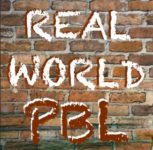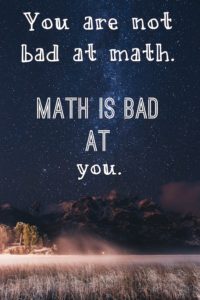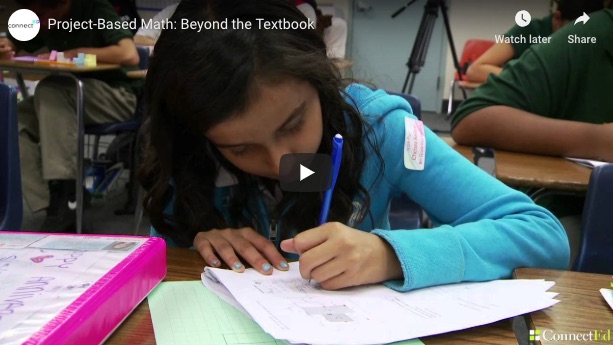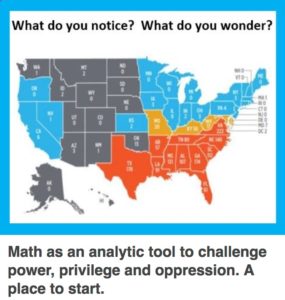Banish the stigma: you are not bad at math. Math is bad at you.
 We can move math beyond worksheets and imaginary word problems. Let’s quit making math about sharing made-up apples, fishes or shoes.
We can move math beyond worksheets and imaginary word problems. Let’s quit making math about sharing made-up apples, fishes or shoes.
Let’s tie math to the real world: real problems for students to solve, what’s going on around them, and how students learn. If you’re trying to save the world, you’re not gonna let a little math get in the way, are you?
Here’s 4 ways to make math more relevant for students and for teachers.
 First take the terror out of trigonometry.
First take the terror out of trigonometry.
If you think about it, math is a foreign language for everyone the world over. No matter what language or which alphabet you use to communicate, you have to switch over to a different set of symbols when it’s math time. Combine that with musty textbooks, incomprehensible graphs and basically any classroom from 1956-1998 inclusive and many people either struggle with math or are averse to it.
So how do you encourage a math-happy mindset?
Jo Boaler and her students at Stanford University have created have created a free online course for students aimed at creating a positive math mindset. YouCubed combines videos, quizzes and lessons all aimed at making math feel friendlier.
Youcubed is a great place to start shifting your math instruction and plans. Dip a toe in: do a week of Inspirational Math with your students. The problems are accessible, but also allow room for deep exploration and challenge. This is a resource that can be used all year long.
Right! Now that we’re all in a good place with this math business, let’s look at four ways we can stay there.
1. We’re all in this together: collaborative math ftw
Students learn a great deal through collaborative discussions about math concepts. Talking through a math problem with a partner gives students a chance to express concepts in a small group format. They can try new things and learn form each other, and we know that this is one of the best ways for middle grades students to learn. At Williston Central School, in Williston VT, students in sixth grade math educator Jared Bailey’s class captured the discussion that ensued as they grappled with division as a group.
The discussion started with a lot of confusion (and some consternation), so the students quickly developed a norm for their conversation: if you have the pencil, you do the talking. Woot! Let’s hear it for the Speaking Pencil! Next, the students shared a couple different theories about how division works. Then Bailey brought some structure to the conversation with a dollars and cents example. And at that point, students broke into smaller conversations to work on the new example, while still respecting the Speaking Pencil.
For people (especially adults) for whom the phrase “grappled with division” brings on hives, the idea that you can talk about what’s confusing you, that you can even express that confusion in a supportive peer group feels like a barrel of Benadryl, baby.
2. Hands-on math: the project-based learning approach
When students do hands-on projects in math, they create a mental scaffold of concepts. And they may not even know they’re doing it, what with being so caught up in saving salamanders, measuring contamination in a nearby water source or determining how much food is needed to address a shortfall in their community.
It’s all math, but it’s cleverly disguised as Getting Things Done. And even if students still aren’t entirely sold on math (keep pushing the YouCubed), I bet they really like Getting Things Done.
The federal SLOPE (STEM Learning Opportunities Provide Equity) program aims to tie increased proficiency in 8th grade algebra to improved academic outcomes. We’re all on board with that, right? But algebra activities here include code-cracking, basic programming projects, making model wind turbines and designing mobility-access ramps for school buildings. The teacher in the above video found increased student achievement of conceptual knowledge in the students who participated in a PBL approach. Students reported more engagement, more fun, and more excitement about math through this approach.
3. Use current events data, maps, charts and tables to explore issues
As a response to the violence in Charlottesville, many teachers were sharing resources for teaching about issues of history, race, identity and community. Many were interested helping students challenge their thinking and deepen their understanding about issues of power, privilege and oppression.
Sara Van Der Werf answered the call— with math.
She found several maps of America, and asked direct, simple questions:
- What do you notice?
- And what do you wonder?
- What else?
She included maps of confederate monuments, census data about where in the country has the highest rate of African Americas, and where the hate groups in this country are located. Analysis of these maps can lead to powerful learning. Learning about geography. Learning about how to read graphs and maps. And, learning to see connections between data points to discover a larger theme. These are skills our students need, and an understanding our society needs, too.
4. Get students up and moving, ideally collaboratively working on a vertical surface
There is a movement in math. Toward active, engaged bodies. From the straight forward but oh so helpful stand and talk (thanks again, Sara Van Der Werf), where instead of turning and talking, student have to stand, walk to find a partner, and do a quick collaborative task. Engaging, social, and movement all in one small tweak. The incomparable Laura Botte teaches math at Edmunds Middle School, in Burlington VT, and her students are always in motion. They calculate pi by doing yoga, they race scooters through the hallway just like Isaac Newton did, and they do hopscotch calculations. Furniture is irrelevant; dance breaks are the norm.
[huge_it_slider id=”10″]
Ready to go bigger? Try 360 math.
360 math is turning the organization of the class on its head. It is a way to teach math that involves movement, collaboration, and engagement. It involves structuring class like this, according to 360 math’s website:
- The exchange: greeting and welcoming students
- Rewind: kids experience success with a quick problem at their level
- Micro-lecture: 10 minutes of direct instruction
- Practice: students work on low floor, high ceiling problems on white board or chart paper around the room, allowing for movement, collaboration, and exploration of concepts. (There is research to support embedding movement into math, and kids that work on a vertical plane retain more! (find and link).
- Proof: an exit ticket or other check in about the skill, done independently. (I would like to add students could work in collaborative groups on some problems, and then present the proof to the whole class and reflect).
- Progress bar: students mark their progress so they can see the growth in their efforts. Brain research supports this kind of monitoring and self assessment.
The teacher stands at the center of the room, taking in who needs help, support, more challenge, or direction. The teacher is active, gathering formative assessment, and supporting students. Read what one teacher has to say about using this approach.
What do students think? See what this class has to say (and when have you seen this much laughter and excitement about math?).
Lastly, three quick tips from a recent Edutopia article on student-centered math class:
- “Start with good problems
- use visibly random groups
- and work regularly on vertical nonpermanent surfaces.”
These approaches can be put into practice in most math classes with little new gear (chart paper, maybe!) and resources.
One simple way I had students move during math was at the end of class. Students were asked to proclaim something– something they learned, re-learned, enjoyed, or experienced. They were able to stand on chairs (ala Good Will Hunting) for these proclamations. Every day, we ended class with these reflections, and if I forgot, students asked for it, because they loved ending class this way. And yes, the world does indeed look different from up there.
tldr; how to engage students in math?
- Turn around anti-math attitudes
- Use some project-based approaches with hands-on math
- Use current events data, maps, charts and tables to explore issues
- Get students up and moving, ideally collaboratively working on vertical surfaces.
What do you do to make math real and relevant for students?




This is beautiful! Thank you!
Thank you so much Saloni! You are more than welcome!